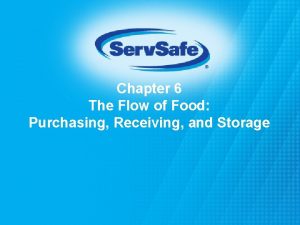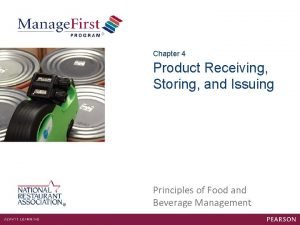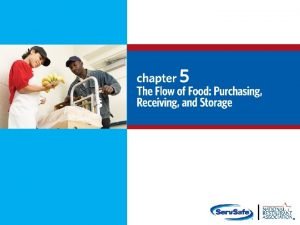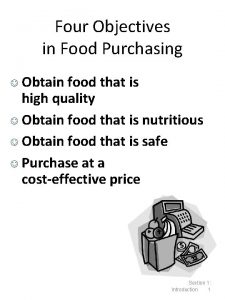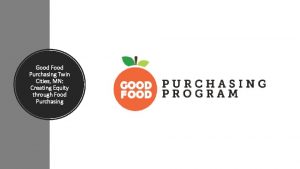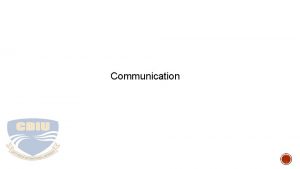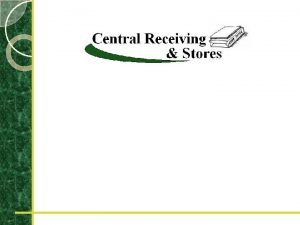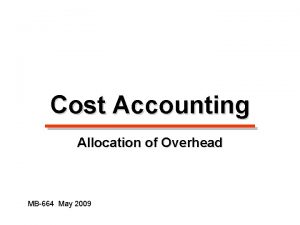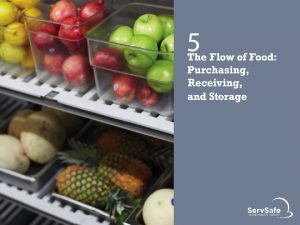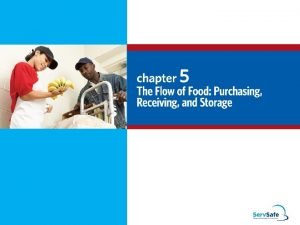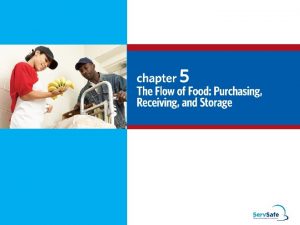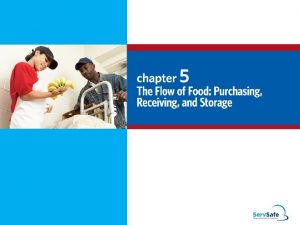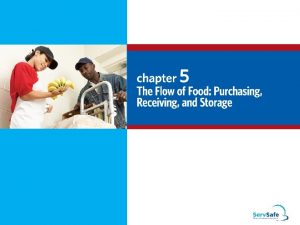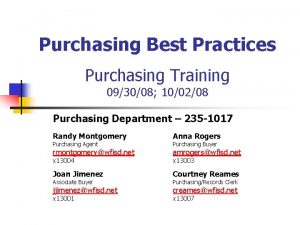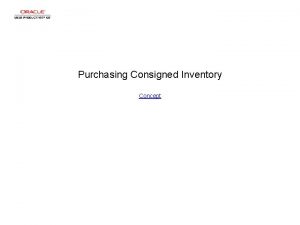The Flow of Food Purchasing and Receiving 6























- Slides: 23

The Flow of Food: Purchasing and Receiving 6 -1

Apply Your Knowledge: Test Your Food Safety Knowledge 1. True or False: A delivery of fresh fish should be received at an internal temperature of 41°F (5°C) or lower 2. True or False: Turkey should be rejected if the texture is firm and springs back when touched 3. True or False: You should reject a delivery of frozen steaks covered in large ice crystals 4. True or False: If a sack of flour is dry upon delivery, the contents may still be contaminated 5. True or False: A supplier that has been inspected and is in compliance with local, state, and federal law can be considered an approved source 6 -2

Suppliers Choose suppliers who get product from approved sources Approved sources: n Have been inspected n Are in compliance with applicable local, state and federal law 6 -3

General Receiving Principles When Receiving Food: n Schedule deliveries for off-peak hours n Receive only one delivery at a time n Make sure enough trained staff are available n Inspect deliveries immediately and carefully 6 -4

General Receiving Principles When Receiving Food: continued n Use calibrated thermometers to sample temperatures n Check shipments for: n Intact packaging n Refreezing n Prior wetness n Pest infestation 6 -5

Checking the Temperature of Various Types of Food Meat, Poultry, Fish n Insert thermometer stem or probe into the thickest part of the product (usually the center) 6 -6

Checking the Temperature of Various Types of Food ROP and Bulk Food: n Insert thermometer stem or probe between two packages n As an alternative fold packaging around thermometer stem or probe 6 -7

Checking the Temperature of Various Types of Food Other Packaged Food: n Open the package and insert thermometer stem or probe into the product 6 -8

Receiving Criteria for Meat Accept Temperature: 41 F (5 C) or lower Color: Reject Temperature: > 41 F (5 C) Color: n Beef: bright cherry red n Beef: brown or green n Lamb: light red n n Pork: light pink meat, firm white fat Lamb: brown, whitish surface covering the lean meat n Pork: excessively dark color, soft or rancid fat Texture: firm and springs back when touched Odor: no odor Packaging: intact and clean Texture: slimy, sticky, or dry Odor: sour odor Packaging: broken cartons, dirty wrappers, torn packaging, vacuum packaging with broken seals 6 -9

Receiving Criteria for Poultry Accept Reject Color: no discoloration Color: purple or green discoloration around the neck; dark wing tips (red tips are acceptable) Temperature: 41 F (5 C) or lower Texture: firm and springs back when touched Odor: no odor Packaging: product should be surrounded by crushed, self-draining ice Temperature: > 41 F (5 C) Texture: stickiness under wings or around joints Odor: abnormal, unpleasant odor 6 -10

Receiving Criteria for Fish Accept Reject Color: bright red gills; bright shiny skin Color: dull gray gills, dull dry skin Temperature: 41 F (5 C) or lower Texture: firm flesh that springs back when touched Odor: mild ocean or seaweed smell Eyes: bright, clear, and full Temperature: > 41 F (5 C) Texture: soft flesh that leaves an imprint when touched Odor: strong fishy or ammonia smell Eyes: cloudy, red-rimmed, sunken Packaging: product should be surrounded by crushed, self-draining ice 6 -11

Receiving Criteria for Shellfish Accept Temperature: n n Live: receive on ice or at an air temperature of 45° F (7°C) or lower Shucked: receive at an internal temperature of 45° F (7°C) or lower Odor: mild ocean or seaweed smell Shells: closed and unbroken (indicates shellfish are alive) Condition: if fresh, they are received alive Reject Temperature: n Live: air temperature > 45° F (7°C) n Shucked: internal temperature > 45° F (7°C) Texture: slimy, sticky, or dry Odor: strong fishy smell Shells: broken shells Condition: dead on arrival (open shells that do not close when tapped) 6 -12

Receiving Criteria for Shell Eggs Accept Reject Odor: no odor Odor: sulfur smell or off odor Shells: clean and unbroken Shells: dirty or cracked Temperature: receive at an air temperature of 45 F (7 C) or lower Temperature: air temperature > 45 F (7 C) 6 -13

Receiving Criteria for Dairy Products Accept Temperature: 41 F (5 C) or lower unless otherwise specified by law Milk: sweetish flavor Butter: sweet flavor, uniform color, firm texture Cheese: typical flavor, texture, and uniform color Reject Temperature: > 41 F (5 C), unless otherwise specified Milk: sour, bitter, or moldy taste Butter: sour, bitter, or moldy taste; uneven color; soft texture Cheese: abnormal flavor or texture, uneven color, unnatural mold 6 -14

Receiving Criteria for Fresh Produce Accept Reject Conditions: vary according Conditions: grounds for rejecting one to produce item; only accept items that show no sign of spoilage produce item may not apply to another; signs of spoilage include: n Insect infestation n Mold and cuts n Wilting and mushiness n Discoloration and dull appearance n Unpleasant odors and tastes Reject fresh-cut produce items that have passed their expiration date. 6 -15

Receiving Criteria for Refrigerated Ready-To. Eat Food Accept Reject Packaging: intact and in good condition Packaging: torn packages or packages with holes; expired product use-by dates Temperature: 41 F (5 C) or lower unless specified by the manufacturer Temperature: > 41 F (5 C) unless otherwise specified 6 -16

Receiving Criteria for Frozen Processed Food Accept Reject Packaging: intact and in good condition Packaging: torn packages or packages with holes; fluids or frozen liquids in case bottoms, ice crystals or water stains on packaging (evidence of thawing and refreezing) Temperature: frozen food should be received frozen; ice cream should be received at 6°F to 10°F ( – 14°C to – 12°C) Temperature: food that is not frozen; ice cream at temperatures > 6°F to 10°F (– 14°C to – 12°C) Product: large ice crystals on product (evidence of thawing and refreezing) 6 -17

Receiving Criteria for Canned Food Accept Can: can and seal are in good condition Product: normal color, texture, odor Reject Can: swollen ends, leaks and flawed seals, rust, dents, no labels Product: foamy, milky, or has an abnormal color, texture, or odor 6 -18

Receiving Criteria for Dry Food Accept Packaging: intact and in good condition Product: normal color and odor Reject Packaging: holes, tears, or punctures; dampness or water stains on outer cases and inner packaging (indicates it has been wet) Product: abnormal color or odor; spots of mold, or slimy appearance; contains insects, insect eggs, or rodent droppings 6 -19

Receiving Criteria for Bakery Goods Accept Reject Packaging: intact and in good condition Packaging: torn packaging, signs of pest damage Temperature: receive at the temperature specified by the manufacturer Temperature: temperatures higher than those specified by the manufacturer Product: signs of pest damage, mold 6 -20

Receiving Criteria for Potentially Hazardous Hot Food Accept Reject Container: able to maintain proper temperatures; undamaged Container: unable to maintain proper temperatures; damaged Temperature: 135 F (57 C) or higher Temperature: <135 F (57 C) 6 -21

Apply Your Knowledge: Accept or Reject it? Which products should be rejected? 1 2 3 4 5 Raw beef roasts that are bright red Chicken received at an internal temperature of 50 F (10 C) Eggs received at an air temperature of 45 F (7 C) Fresh salmon with flesh that springs back when touched Flour that is damp 6 -22

Apply Your Knowledge: Accept or Reject it? Which products should be rejected: continued 6 7 Live oysters that have a mild seaweed smell Frozen meat with large ice crystals on the meat and package 8 Clams with shells that do not close when tapped 9 Fresh turkey with dark wing tips 6 -23
 The flow of food purchasing receiving and storage
The flow of food purchasing receiving and storage Shellstock identification tags
Shellstock identification tags Stock receiving and issuing procedures
Stock receiving and issuing procedures Purchase food from reputable suppliers
Purchase food from reputable suppliers Centralized purchasing and decentralized purchasing
Centralized purchasing and decentralized purchasing Receiving in food flow
Receiving in food flow Purchasing images
Purchasing images Food objectives
Food objectives Zoe hollomon
Zoe hollomon Unit 2 food food food
Unit 2 food food food Food chain sequence
Food chain sequence Direct putaway
Direct putaway An institution for receiving keeping and lending money
An institution for receiving keeping and lending money What is love tank
What is love tank Sending or receiving information
Sending or receiving information Unlv pcard
Unlv pcard Giving and receiving feedback by phil rich
Giving and receiving feedback by phil rich Sending and receiving signals are special constructs of
Sending and receiving signals are special constructs of Complex transmitting and receiving unit
Complex transmitting and receiving unit Uncc receiving and stores
Uncc receiving and stores An ordering and receiving materials cost pool
An ordering and receiving materials cost pool Dfd to structure chart
Dfd to structure chart Transform flow and transaction flow
Transform flow and transaction flow Rotational flow means
Rotational flow means
